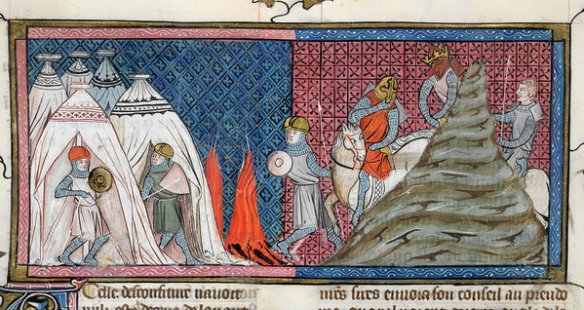Louis VII of France reaches the crusaders camp
We know far more about the French than the German forces in the Second Crusade, because Otto of Freising, an eyewitness, wanted “to write not a tragedy but a joyous history” and left the sad task to others (1.47), most notably, it turned out, Louis VII’s chaplain Odo of Deuil. Consequently, we have only fragmentary information about Frederick’s experiences on crusade, some of it supplied by Odo.
There were repeated clashes between the crusaders and the local population and the Greeks as the German army marched towards Constantinople. Frederick was involved in one nasty incident. Greek soldiers in August 1147 robbed and killed a sick German crusader who was recuperating in a monastery outside Adrianople. On Conrad’s orders Frederick went back to the monastery and burned it, executed the perpetrators, and sought the return of the stolen money. Only the intervention of the Greek commander Prosuch prevented a further escalation of the conflict. On 8 September a German army was destroyed during a flash flood, in which only Welf VI and his nephew were spared because they had camped together on a hillside, away from the rest of the army in the valley.
Conrad arrived outside Constantinople after 9 September 1147, but did not enter the city and for reasons of protocol the two monarchs-Conrad and Manuel I-did not meet. The German forces crossed the Bosporus at the end of the month and reached Nicaea (now Iznik). The bulk of the army under Conrad’s command left Nicaea on 15 October and set out on a diagonal course across Anatolia in the direction of Iconium (now Konya) via Dorylaeum (now Sarhüyük), located at the edge of the Anatolian plateau and in the no man’s land between the Greeks and Turks. Otto of Freising led a smaller contingent, composed largely of non-combatant pilgrims, on the much longer but supposedly safer coastal route, where they were ambushed. The king grossly underestimated how long the passage across Anatolia would take and overestimated the availability of supplies. Mounted Turkish archers, employing hit-and-run tactics, constantly harassed the army; and on 26 October, Conrad called a council of the princes. Odo of Deuil summarized their dilemma thus: “They had to advance or retreat, but hunger and the enemy and the unknown mountain labyrinth kept them from advancing; and hunger and fear of dishonor kept them from retreating. . . . Certainly they would prefer a glorious death to a base life, but if baseness stains both alternatives it is better to be saved basely by prompt action than to die basely, though without reproach.” They decided to return to Nicaea. On the way back, the rearguard was annihilated and Conrad was wounded. The king sent Frederick to Louis VII to inform him of the disaster, to invite him to a meeting, and to ask for his help.
The two monarchs met for the first time near Nicaea and decided to continue on together. At Esseron, on the coastal road between Nicaea and Smyrna (now Izmir), Conrad and Frederick allegedly rejected sometime after 11 November Odo’s entreaty, relayed by Louis, that the Staufer return Stauf and Esslingen to St. Denis. Conrad celebrated Christmas at Ephesus (now Efes), where he became ill; he was visited by the Byzantine emperor Manuel and his wife Eirene, Conrad’s adopted daughter. Louis went on alone, while Manuel and Eirene transported the sick Conrad and his entourage, including presumably Frederick, by ship to Constantinople for treatment. They remained at the imperial court until 7 March 1148, when they left on Byzantine vessels for the Holy Land. Before their departure, Manuel supplied Conrad with money to raise a new army; and they agreed to a joint attack, upon Conrad’s return, on King Roger II of Sicily. Conrad along with the chancellor, the bishop of Basel, Frederick, Henry Jasomirgott, and Welf VI, arrived in Acre the week before Easter (11 April) and visited Jerusalem after Easter. It was on this occasion that Frederick was so impressed by the charitable activities of the Hospitalers.
Siege of Damascus
The leaders of Germany, France, and the Holy Land met at Palmarea near Acre on 24 June and decided to attack Damascus. The participants included Conrad, Otto of Freising, Frederick, Henry Jasomirgott, Welf VI, Louis VII, King Baldwin III of Jerusalem, and his mother Queen Melisende. The brief siege of Damascus lasted from 24 to 28 July. Frederick, according to Gilbert of Mons, writing five decades later, “is said to have prevailed in arms before all others in front of Damascus.” On 8 September, Conrad sailed from Acre for the Byzantine Empire.
Henry Jasomirgott married Manuel’s niece Theodora on Conrad’s return to Constantinople; their union sealed the Babenberg-Byzantine anti-Hungarian alliance. Before Frederick departed for home, he and Conrad, in the so-called Treaty of Thessalonica, confirmed with an oath the agreement the king had reached with Manuel in the winter of 1148 to launch a joint attack on King Roger II of Sicily. Conrad sent Frederick “ahead to inquire into, or rather to strengthen, the condition of the empire.” Traveling via Bulgaria and Hungary, Frederick arrived in Germany in April 1149; he hanged several of his ministerials who had disturbed the peace in his absence. After spending some additional time in Greece to recuperate, Conrad sailed along the Dalmatian coast and entered imperial territory in Pola (now Pula, Croatia) at the southern tip of Istria. He reached Regensburg, where from 29 May to 1 June he held a well-attended assembly. Frederick and his uncle met for the first time after the Second Crusade in Frankfurt on 21 August.
Frederick learned from the debacle of the Second Crusade the need for careful preparation. While only five months elapsed between Conrad’s taking of the cross in Speyer (28 December 1146) and his departure from Regensburg (end of May 1147), Frederick spent nearly a year making diplomatic and logistical arrangements before leaving in 1189 on his meticulously planned expedition, namely the Third Crusade.
